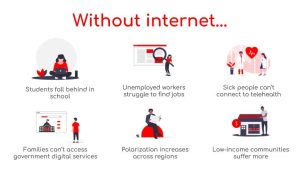

Psychologist doctor online consultation. Psychotherapy practice, psychological help, psychiatrist consulting patient. Psychology. Trendy flat cartoon style. Vector illustration on white background

1. When I read Sieck et al. (2021), I was struck by the idea that digital inclusion is a “super social determinant of health.” This phrase helped me realize how deeply technology influences almost every aspect of our lives—our jobs, education, relationships, and healthcare. I used to think of internet access as a luxury, but this framework made me see it as essential for health and equity.
In Figure 1, the elements that stood out to me were digital access and digital literacy. Without both, people cannot fully benefit from resources like online doctor appointments or finding reliable health information. The feedback loop in the diagram also resonated with me; it illustrates how a lack of access doesn’t just affect one area of life but keeps people trapped in cycles of disadvantage. I found myself reflecting on how many things I do online daily, and I realized how isolating it would be to lose that connection.
2. I believe Sieck et al.’s framework effectively describes the impact of the digital divide. It’s easy to view the “digital divide” as simply an issue of who has or doesn’t have Wi-Fi, but this model explores deeper issues. It shows how digital inclusion is connected to all other social determinants of health. This realization made me understand that when we address the digital divide, we are also tackling broader inequalities in education, income, and healthcare. To me, that’s what makes this framework powerful it places technology access at the core of social justice and health equity.
3. Sanders and Scanlon (2021) introduced me to a different perspective on the digital divide one rooted in justice and fairness. The most impactful part for me was their discussion about education and economic opportunity. I thought about students during the pandemic who had to sit outside libraries or fast-food restaurants just to get Wi-Fi for their classes. That situation is not just inconvenient; it is fundamentally unfair and deeply unequal.
Their arguments were compelling because they connected the lack of access to larger systems of inequality. They clarified that digital exclusion does not happen by accident; it is shaped by economic and policy decisions. I think they effectively defined the problem by illustrating how the digital divide reinforces other forms of social exclusion. However, I wish they had spent more time discussing digital literacy, as even with access, people need the skills to navigate online resources effectively.
4. When Sanders and Scanlon (2021) discussed strategies for closing the digital divide, I found the idea of community-based digital literacy programs especially promising. I appreciate this approach because it focuses on empowering people in their own communities. Teaching digital skills locally helps individuals feel more confident and connected while fostering local support networks.
On the other hand, the concept of nationwide broadband expansion seemed a bit unrealistic to me. Don’t get me wrong I wish it could happen but it is such a massive project that it would require long-term political will and funding that may not always be available. I believe the best way forward would be to combine government support with grassroots community programs, ensuring local leaders have a voice in how those resources are allocated.
5. The article by Craig et al. (2021) opened my eyes to how technology can be life-changing for specific groups, like LGBTQ+ youth. Using Affirmative Cognitive Behavioral Therapy (CBT) through telehealth allows therapists to reach young people who may not feel safe seeking help in person. I found that idea powerful. It’s not just about using technology; it’s about creating access and safety for people who often face barriers to care.
What I appreciated most about their approach was its affirming nature. They didn’t just offer therapy; they provided validation and connection through a digital space. This ties back to Sieck et al.’s point about digital access being a foundation for well-being. If a young person lacks the technology or privacy to participate in a telehealth session, it adds another layer of exclusion. These articles connect seamlessly demonstrating that digital access is not just about convenience, but also about justice, health, and belonging.
References
Craig, S. L., Eaton, A. D., Pascoe, R., Iacono, G., & Austin, A. (2021). Adapting clinical skills to telehealth: Applications of affirmative cognitive behavioral theory with LGBTQ+ youth. Cognitive and Behavioral Practice, 28(4), 643–654. https://doi.org/10.1016/j.cbpra.2021.01.002
Sanders, C. K., & Scanlon, E. (2021). The digital divide is a social justice issue: The COVID-19 pandemic, small business, and minority communities. Journal of Economic, Race, and Policy, 4(2), 130–139. https://doi.org/10.1007/s41996-021-00081-0
Sieck, C. J., Sheon, A., Ancker, J. S., Castek, J., Callahan, B., & Siefer, A. (2021). Digital inclusion as a social determinant of health. NPJ Digital Medicine, 4(1), 52. https://doi.org/10.1038/s41746-021-00413-8
0 Comments